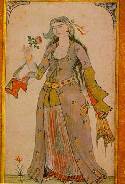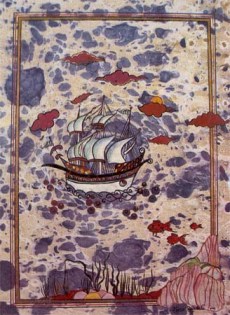
.Turkish Miniature
The only examples of monumental art of picture in Islamic history could exist during the times of Umayyad Dynasty, between VII and VIII centuries.The contacts, emerging from the conquests, with different cultures' traditional pictorial arts resulted in naturalist pictures and mosaics, which reflect late Hellenistic and Persian customs of art, on the walls of various religious and civilian buildings.
During the IX century, a different point of view dominated Islamic art, and although there is no absolute statement in Quran that forbids picture, some people chose to comment some verses as "the ones who draw the pictures of living things will be questioned in the doomsday". After those comments, pictures in Islamic art evolved to static, shadow-free and perspective-free forms avoiding anatomic proportions. Thus, without perspective, shadow, and motion, the figures in the pictures would look lifeless. Consequently, in late XIV. century, Islamic Miniatures reached its classical identity.
Ottoman miniature themes includes accession to throne (cülus), religious festival gatherings (muayede), palace entertainments (meclis), ambassador receptions (sarayda kabul), rewarding of statesmen and ambassadors (hilat verilisi), council meetings (divan toplantisi), Topkapi Palace, life out of the palace -i.e. military expeditions, circumcision rituels, trade groups' entertainments-, sports contests, funerals, portraits of Ottoman rulers, war and siege, hunting, city depictions, Prophet stories such as Adam and Eve, Hz. Muhammed's miraculous journey to heaven, ascension of Christ, and many other events.
links:
Turkish Ministry of Culture and Tourism
Miniatures from Topkapi Palace
sample miniatures:
Omer Hayyam Rubaili miniature by Omer Faruk Atabek
Mevlana Rubaili miniature by Omer Faruk Atabek
Okmeydani Feasts
Sufi Theme miniature-1
Sufi Theme miniature-2
Sufi Theme miniature-3
